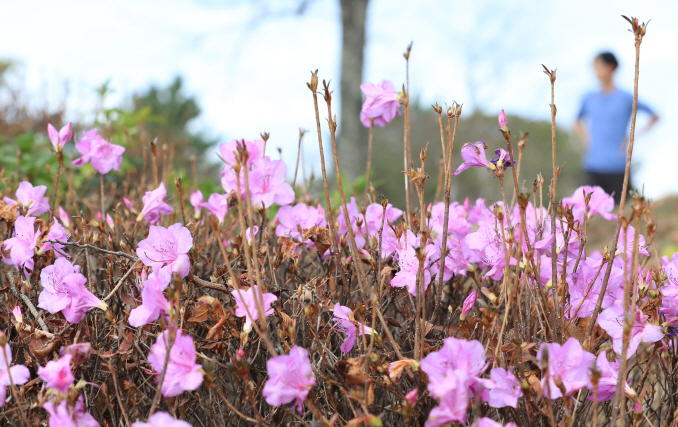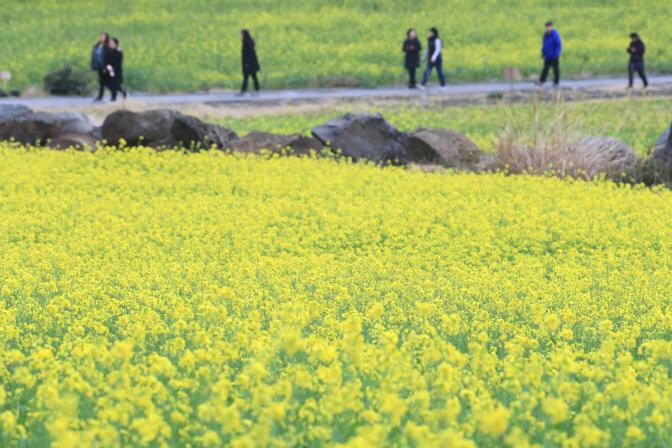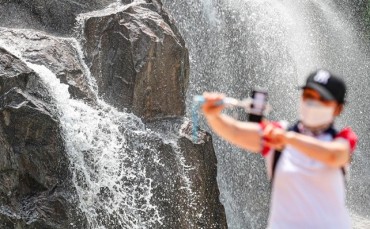
Amid unseasonably warm weather, royal azalea is in full blossom on a university campus on Jeju Island on Jan. 7, 2020. (Yonhap)
SEOUL/JEJU, Jan. 7 (Korea Bizwire) — Residents and visitors to Jeju Island witnessed the warmest January weather on Tuesday, with the daily low on the southern resort island rising to an all-time high of 18.5 C, a weather agency said.
According to the Korea Meteorological Administration (KMA), some regions on the nation’s southern coast also reported their highest daily low temperatures for January amid an extended spell of unseasonably warm weather gripping the Korean Peninsula.
Jeju Island’s morning low of 18.5 C is higher than its 30-year January average of 14.8 C recorded between 1981 and 2010, the KMA said, noting it is just 0.4 C lower than the previous day’s highest temperature of 18.9 C.
In the nation’s southern regions, Gochang of North Jeolla Province and Suncheon of South Jeolla Province also recorded their highest January daily lows of 10.3 C and 7.1 C, respectively, it noted.
Ulleung Island in the East Sea and Heuksan Island in the Yellow Sea also reported their second-highest daily lows for January at 8.2 C and 11.3 C, respectively, while Mokpo in South Jeolla Province and Buan and Jeongeup, both of North Jeolla Province, witnessed their third-highest daily lows of 9.4 C, 7.7 C and 9.6 C, respectively, for the month.
The KMA said the unseasonably warm weather has something to do with rain that soaked the entire nation from Monday.
It explained that while the Siberian high pressure, which usually brings cold air to Korea during the winter season, recently weakened, comparatively warm air has flowed into the nation along the southwesterly winds from the Pacific.
The absence of the so-called radiant cooling phenomenon has also contributed to the unseasonably high temperatures in the southern regions, it added.
“This winter, the cold is generally weaker and temperatures are higher than usual amid frequent rainfall. The development of high atmospheric pressure in the southern regions also led to the unseasonably high temperatures. The phenomenon of the record high daily low temperatures in January is exceptional,” a KMA official said.
On Jeju Island, the daily high rose to 23 C, the highest January temperature in 97 years since record keeping began in 1923.
The KMA said the daily high is about 7 to 14 C higher than the 30-year January average on the island.

Yuchae(Canola) flower are in full blossom on Jeju Island on Jan. 7, 2020, as the island’s daily high temperature rose to 23 C. (Yonhap)
On the streets of Jeju, lightly clad residents and tourists were enjoying the springlike weather, with some of them seen wearing half-sleeve shirts.
People running on coastal roads or playing basketball in sports parks didn’t look cold despite wearing shorts and short sleeves.
A company employee surnamed Kang, who showed up at work in short sleeves, said, “I was doubtful when the temperature was forecast to rise to 21 C today. I came to work in short sleeves and everybody envied me.”
At cafes, cold drinks sold better than hot ones.
“I wore a winter jacket unaware of unusually hot temperatures and sweat a lot even while standing still. I just now ordered cold coffee. There is little snow this winter, and the temperature is high so there is no winter atmosphere,” said a cafe client in the city of Jeju.
A 50-year-old tourist, who just landed at Jeju International Airport, said he was disappointed with the island’s unseasonal winter weather because he went there to see snow-covered Mount Halla.
“I’m afraid snow on Halla will melt as rain is forecast for tonight. I may run into spring flowers instead of snow while trekking on Mount Halla,” said the tourist, who introduced himself as Park.
The KMA said the temperature will fall slightly on Jeju Island from Wednesday, when cold air comes down from the northwest.
Daytime temperatures will be similar to the 30-year average, but wind chill temperatures will drop more sharply due to strong winds.
(Yonhap)






